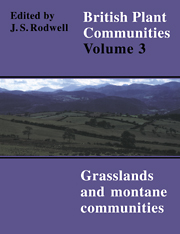Book contents
- Frontmatter
- Contents
- List of Figures
- Preface and Acknowledgements
- Preamble
- Mesotrophic Grasslands
- Community Descriptions
- Calcicolous Grasslands
- Community Descriptions
- Calcifugous Grasslands and Montane Communities
- Community Descriptions
- Index of Synonyms to Grasslands and Montane Communities
- Index of Species in Grasslands and Montane Communities
- Bibliography
U9 - Juncus Trifidus-Racomitrium Lanuginosum Rush-Heath
Published online by Cambridge University Press: 04 July 2020
- Frontmatter
- Contents
- List of Figures
- Preface and Acknowledgements
- Preamble
- Mesotrophic Grasslands
- Community Descriptions
- Calcicolous Grasslands
- Community Descriptions
- Calcifugous Grasslands and Montane Communities
- Community Descriptions
- Index of Synonyms to Grasslands and Montane Communities
- Index of Species in Grasslands and Montane Communities
- Bibliography
Summary
Synonymy
Rhacomitrium-Carex bigelowii heath, Juncus trifidus-Salix herbacea facies Poore & McVean 1957; Juncetum trifidi scoticum Ingram 1958 p.p.; Cladineto-Juncetum trifidi McVean & Ratcliffe 1962.
Constant species
Carex bigelowii, Juncus trifidus, Racomitrium lanuginosum.
Rare species
Loiseleuriaprocumbens, Luzula arcuata, Cetraria delisei.
Physiognomy
Juncus trifidus occurs in quite a wide variety of montane communities, sometimes with locally high cover, but it is in certain kinds of Carex-Racomitrium vegetation and particularly in this Juncus-Racomitrium rush-heath that it has the opportunity to play a more important role. Here, in contrast to the former moss-dominated heath, it is usually the most abundant plant, though both Carex bigelowii and Racomitrium lanuginosum occur frequently and, in more sheltered situations, the latter can be co-dominant.
In this respect, then, the community is defined more broadly than Ingram's (1958) Juncetum trifidi, where very open stands predominated. These do occur here, the cover then consisting of little more than widelyscattered rush plants over a virtual wilderness of stony ground and hardly relieving the greyish tone of the landscape. But, in this scheme, the Juncus-Racomitrium heath also takes in some denser patchworks of vegetation and bare gravel and virtually continuous swards; and, even in these last, J. trifidus generally gives a distinct stamp to the heath. It is a rhizomatous perennial, extending by monopodial branching and though, in more sheltered situations, it can spread as a loose turf with shoots over a decimetre tall, exposure to wind and erosion often induces particular growth forms and distinct mosaics of plants over patterned ground (Ingram 1958). Most striking is the ability of the rush to grow as a compact tussock, the tips of the rhizomes being repeatedly inturned by the wind to form a confined and contorted mass of branches up to 20 or 30 cm in diameter. It is such a habit that enables J. trifidus to survive in the mobile gravel of the high montane slopes where freeze-thaw, frost-heave and solifluction are prevalent, and to respond to environmental instability in some striking ways. Constant removal of gravel, for example, by wind and churning tends to make the tussocks grow raised and convex, exposing the dead middle parts even more to the cutting blast of the gales, such that they blow away to leave an annular or crescentic remnant.
- Type
- Chapter
- Information
- British Plant Communities , pp. 396 - 402Publisher: Cambridge University PressPrint publication year: 1992



